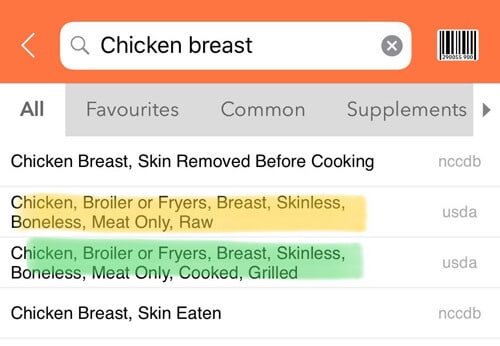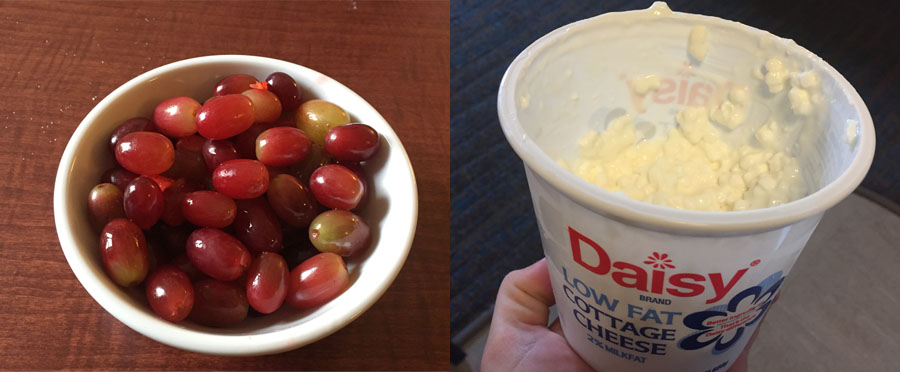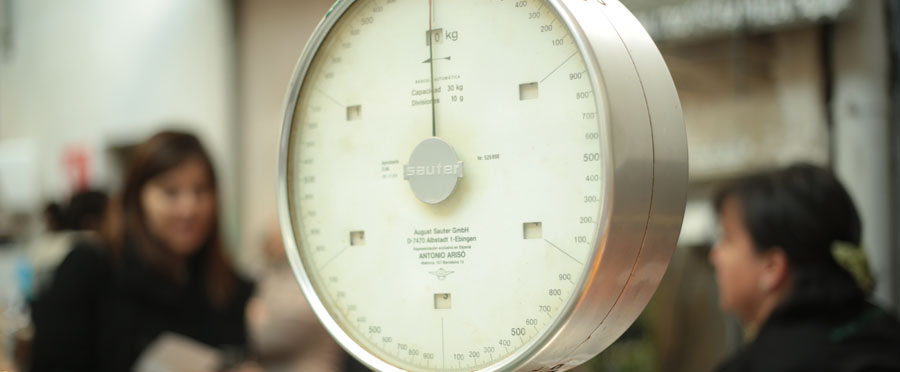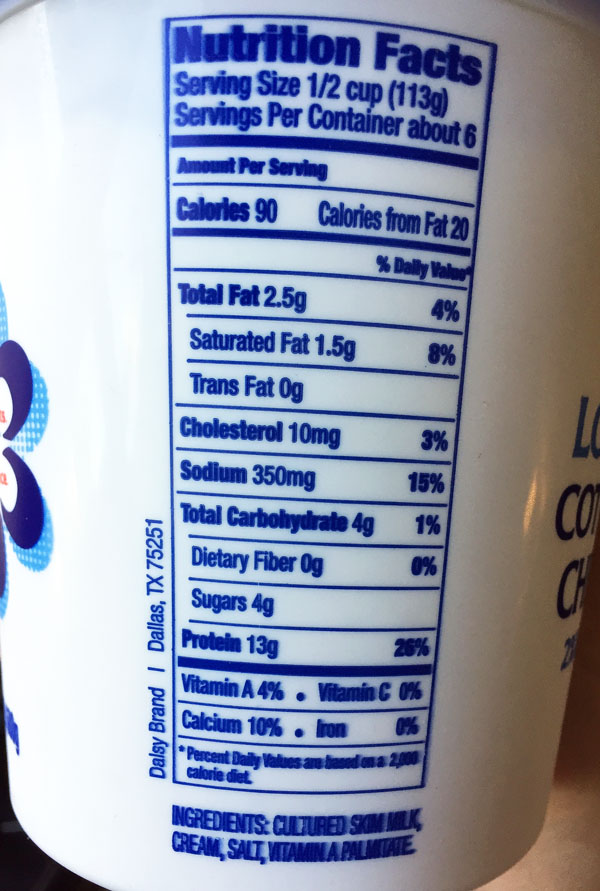Counting macronutrients seems like a confusing process at first. But when you learn how to count macros, everything about changing your body composition becomes a lot easier. Tracking macros allows you to see how much you’re eating on a regular basis, and that gives you the power to make gradual, intentional changes to your diet.
I’ve created the most in-depth and helpful article to help you understand and apply the process for a leaner, more muscular body.
Counting macros made easy in 4 concepts :
- A basic understanding of what macros are
- To know how many calories your body needs each day
- Which tools you need for tracking accuracy
- Developing an easy system that works for you (using my simple methods)
By the time you’re done reading, you’ll know exactly how to track macros accurately for any goal you have, whether that be bulking to gain muscle, fat loss, or weight maintenance.
What Are Macronutrients?

Macronutrients are what makes up the food we eat. They’re known as:
- Protein
- Carbohydrates
- Fat
Macronutrients make up the total calories in our food and are required in large amounts to support life, activity, and cellular processes. Micronutrients are known as vitamins and minerals, which are required in much smaller amounts by the human body.
Alcohol is technically not a macronutrient because it has zero nutritional value (no vitamins or minerals) but it still contains calories and should be tracked if you decide to consume it.
Each macronutrient contains a certain amount of calories per gram, so while this article’s focus is on counting macros, it serves as the higher purpose of controlling and tracking calories.
- 1 gram of protein = 4 calories
- 1 gram of carbohydrate = 4 calories
- 1 gram of fat = 9 calories
- 1 gram of alcohol = 7 calories
Let’s get into each macronutrient and their importance.
Protein

This macro is what we all think of when it comes to building muscle, but it’s also equally important for maintaining muscle mass on a fat loss diet.
Protein is responsible for many functions in the body, but for this guide, we’ll focus mostly on how it helps us repair muscle tissue that’s been broken down by hard resistance training.
When your body undergoes muscle repair, turnover, and thus, growth, this is a physiological process called anabolism, which is why protein can be considered anabolic.
What’s The Ideal Amount To Consume?
The research suggests a range of .8g – 1.5g per pound of body weight. However, depending on your preferences for protein intake, trying to consume 1.5g per pound can be quite the challenging (and sometimes expensive) task. It can also make it harder to get other macros that are equally as important as protein.
JC’s Expert Advice:
For most people, the recommendation of 1 gram per pound of body weight is likely ideal for positively changing your body composition. If you’re very overweight (with more than 50 pounds to lose), then multiplying your body weight by .7 – .8 is a great way to calculate your intake. Read more about the science of how much protein you need per day.
While protein is important for muscle gain, maintenance, and repair, eating above and beyond the above recommendations for daily intake will not magically make your muscles grow faster nor will it aid in faster fat loss.
More is not always better when it comes to protein.
Quality Protein Sources:
- Lean chicken, beef, lamb, turkey, pork
- Fresh fish, canned fish
- Deli meat (turkey and ham)
- Beef broth (gelatin)
- Tendon meat (from the connective tissue of beef, chicken, lamb, pork)
- Dairy (milk, cheese, yogurt)
- Eggs
If you need some more protein-heavy food ideas for your intake, read how to eat more protein.
Carbohydrates

This macro is absolutely necessary for health, performance, and improved body composition. While it may be a hot debate about how many carbohydrates are necessary among low-carb zealots, we know a few things for certain.
The brain uses up to 20% for our daily expenditure, and it runs on glucose, which is the simplest form of sugar broken down in the body[2].
To get technical, the body can survive on zero carbohydrates, but this is not ideal. In this case, the body will break down the protein you’ve eaten, as well as your muscles, to use as glucose.
Carbohydrates are stored in your liver and in your muscles. The stored carbohydrates are known as glycogen, and this is the primary fuel source for your high-intensity activities (hello weight training and sprints).
What’s The Ideal Amount To Consume?
There is no ideal amount for every single person, but I like to see a minimum of 1 gram per pound of body weight at all times. And some people have been known to consume upwards of 500+ grams per day when being active and training regularly.
This is largely dependent on your body size, activity levels, and your primary form of exercise.
JC’s Expert Advice:
A good range to think about is somewhere between 1 and 3 multiplied your body weight depending on the goal (fat loss, muscle gain, maintenance) and activity levels. Carbohydrates are also a precursor to thyroid hormone production, so a diet too low in carbohydrates can spell disaster for thyroid and metabolic health.
Obviously, someone with a high activity level will require more energy than someone who sits all day, so this is the reason for such wide range of carbohydrates.
Quality Carbohydrate Sources:
- Potatoes (all varieties)
- Rice (brown and white)
- Pasta
- Fruit
- Fresh fruit juice (no concentrates)
- All vegetables
- Bread
- Grains
Read Don’t Fall For The Low-Carb Trap to learn more about why low-carb diets aren’t the best solution for most people.
Popular question: “Should fiber be counted toward or subtracted from macro totals?”
Since fiber is not fully digested, some believe you shouldn’t account for it, but for ease of tracking, always account for it when tracking because your intake can vary from day to day and it’s probably not worth worrying about in the end.
FAT

This macro is an essential nutrient we all need, and it helps with the absorption of the fat-soluble vitamins (D, K, E, A). Fat is also an energy source, right behind carbohydrates.
We burn fat when we’re at rest. It’s the backup fuel source and is easily stored in the body as fat. And this makes sense based on how we survived throughout periods of feast and famine.
Fat also helps with hormone production (testosterone for men, progesterone for women), so a diet too low in fat could be detrimental to your hormonal health.
What’s The Ideal Amount To Consume?
It will depend on the individual and their needs, but someone with a higher energy expenditure from more activity will be able to eat more fat due to the demands on their body from an energy balance perspective.
JC’s Expert Advice:
In terms of a range, anywhere from 15-25% of your overall caloric intake is probably ideal. This allows for enough fat in the diet to cover vitamin absorption and hormone production needs, as well as makes your food taste good.
It’s often a misconception that eating a lot of fat will make you fat. But eating lots of fat (or sugar) will not make you fat if you’re maintaining a caloric balance (see my maintenance calorie calculator) or in a deficit. I explain more in this article: Is Sugar Bad For You And Does It Make You Fat?
Quality Fat Sources:
- Coconut oil
- Palm oil
- Olive oil
- Fats (beef, lamb) from grass-fed animals
- Avocado
- Egg yolks
- Dark chocolate
To get a full nutritional education on protein, carbohydrate, and fat, I highly recommend picking up a copy of The First Diet by Sean Bissell. You can read my review here.
ALCOHOL

This macro is a non-nutrient and is not needed by the human body unless you’re just trying to relax or need some liquid courage to talk to that stranger at the bar you fancy.*
In fairly moderate amounts, it is toxic and people die of it every single day. Remember that alcohol does contain calories, and for every gram of alcohol, there are 7 calories.
Here’s a quick guide on a number of calories in your favorite beverages (source):
- Any hard liquor (1 shot) + diet soda (1 ounce serving = 80 calories)
- Wine (5 ounces serving = 120 calories)
- Cider / Beer (12 ounce serving = 180-200 calories)
*but even then, it’s not needed.
JC’s Expert Advice:
I do not condone drinking in excess at all, but I’ve written a guide on how to incorporate alcohol into your diet without completely blowing your diet in the process. See my alcohol and weight loss article.
Energy Balance (Calories In And Out)
Now that you know how macronutrients make up the calories in your food, you have to know that calorie balance influences your weight gain, loss, or maintenance.
If you put your body into a caloric surplus, you will gain weight.
Conversely, if you put yourself into a caloric deficit, you will lose weight. See the fat loss guide for a full explanation on this.
Lastly, if you eat only enough food to maintain your body weight, you’re consuming your so-called ‘maintenance caloric intake.’ See my calorie intake calculator for a good starting point.
Here’s a quick visual explanation of this concept:

How To Count Macros Accurately
Before reading any further, you must understand this one thing: the total macros and calories for the food you’re eating is a very good estimation.
Nothing is exactly 100 calories every single time. For instance, a large apple may contain 25 grams of carbohydrates, but another apple of equal size might contain 23 or 27 grams of carbohydrates.
In the end, you can never know the tiny details, so you should never worry about them. So don’t get caught up in them. Focus on tracking as best you can (using the methods outlined here) and the results will follow.
Scales And Scoops

When tracking your macros, it’s common to use measuring cups and spoons. For instance, a standard serving of peanut butter is 2 tablespoons. However, next to the serving size, you’ll often see a figure in grams. Something like 2 TBSP (32 grams).
So when tracking and measuring, it’s best to use the weight of something, rather than a scoop or spoon, or measuring cup.
Here’s a video demonstration if exactly why using a digital scale is better than relying on scoops, spoons, and measuring cups.
Raw Versus Cooked
If accuracy is a priority, always weigh food in the raw state when possible.
Most labels of animal products represent the raw state (even if frozen) unless otherwise stated.
As an example, on the chicken breast label, it’s likely to read something like the following:
Serving Size: 112g (4oz)
- Total Fat: ~2 grams (it varies depending on how lean the cut is)
- Carbohydrate: 0 grams
- Protein: ~22 grams
These macros pertain to the raw, thawed chicken breast. The same applies to other cuts of meat, like beef, pork, and fish.

Due to the differences in every cut of meat, which can be further influenced by how they’re raised, it’s impossible to know exactly what the macro composition is.
In fact, it’s impossible to know the exact macro composition of anything, as the calorie totals on packages and in the USDA databases are merely very good, educated estimates.
Nothing is exactly 100 calories 100% of the time. Similarly, no steak will have exactly 22 grams of protein per serving. Sometimes it’s more or less due to the amount of fat within the serving.
Many will weigh out their portions cooked, but this can become problematic due to the way the food is prepared. If a food is steamed or baked, it’s going to retain more water than if it’s been cooked on an open flame where much of the water evaporates.
This is even more true for the person who loves meat burnt to a crisp because these meats are sure to weigh far less than the baked version.
Further, 100 grams of baked chicken will contain less protein than 100 grams of grilled blackened (dry) chicken. This illustrates that while you’re eating the same “post-cooked weight,” there will be a difference in calories, and this difference can accumulate over time.
Quite simply, the differences in cooked weight contribute to a substantial margin of error that could potentially throw off your tracking. For accuracy, always weigh your foods in the raw state when possible.
Common Questions:
Q: When weighing out foods raw, how do we enter it in an app like Cronometer?
It’s very straightforward. You simply enter the food you’re wanting to track. See the image here:

The yellow highlight is the raw version and the green highlight is the cooked version.
However, you decide to weigh your food is up to you. I’ve routinely weighed raw and then weighed the same cooked version afterward and I’ve found the macro and calorie counts to be accurate.
Personally, I find it easy to cook a bunch of chicken, beef, or other meat and weigh it in the cooked state.
Q: Will I get the same fat loss results if I weigh food cooked rather than raw?
Yes, as long as you’re being accurate with your tracking, you’ll still be able to get the results you want.
Q: Do you focus on the macros or just the calories when tracking?
Only on the macros because when tracking macros in an app like Cronometer or MyFitnessPal, they will sometimes subtract the fiber found in fruits and vegetables and it can throw off your total calorie count.
The reason they subtract fiber from calorie counts is while carbohydrates are worth 4 calories per gram, fiber doesn’t fully digest, so it’s typically worth around 1-2 calories per gram.
Source: “The US Food and Drug Administration (FDA) estimates that fibers fermented by bacteria provide about 2 calories per gram of fiber.”
Portion Sizes (what they look like)
Portion sizes are going to vary from person to person and they’re solely based on how you prepare your meals. A standard serving size of chicken is around 112 grams (4 ounces). This gives you about 22 grams of protein ‘per serving’ but what if you need to eat more protein in that meal?
You might double or triple that serving size in order to reach the total amount of protein. So a serving size for you might be 300 grams while 150 grams works well for someone else.
For example, one of my go-to breakfasts is the following:
- 350 grams of Daisy 2% cottage cheese
- 300 grams of grapes
- 2 coffees with milk, collagen protein powder, sugar
Here’s a photo of the grapes and cottage cheese I eat frequently:

Now I don’t have to weigh this out every time I make it because I know the following:
- 350 grams is about half a large container of Daisy 2% cottage cheese.
- A small bowl of grapes is around 300 grams

This is the so-called ‘eyeballing method’ of tracking your macros without having to weigh everything out every time you eat. I cover more of this later in this guide in the long term success with counting section.
Tracking Macros: My Favorite Tools
Before phone apps were as advanced as they are now, I used to track everything on paper by hand. I even have old notebooks where I tracked the individual macronutrients from breakfast, lunch, and dinner.
However, with applications on our phones and desktops, it’s easier than ever.
If you want to know how to track macros accurately, here are some recommended apps.
Cron-o-meter is my favorite tool because the iPhone version is easy to use and the desktop version is equally good. I mostly like it because it allows me to see how I’m doing with my micronutrient intake.
Here’s a quick video walkthrough of how I use it on my phone and desktop:
MyFitnessPal is a common tracking tool, and many of my clients have used it with much success.
FatSecret is another tracking tool many people seem to like and I’ve used it before.

In addition to apps, you’ll also need a good kitchen scale. There are a ton of options on Amazon and they’re very affordable. I like a digital scale because it allows you to get very precise, even down to the gram, if necessary.
I’m currently using this scale (Etekcity Digital Multifunction Food Kitchen Scale). But here’s a list of scales I’ve used in the past (all recommended):
- Ozeri Touch Professional Digital
- Food Scale By Simple Health
- DecoBros Digital Multifunction Kitchen Scale
- Ozeri Pronto
A Simple Macro Counting System
Ideally, you’ll want to make counting macros as simple as you possibly can, at least in the beginning.
Counting macros made easy, with 2 concepts:
- You’ll learn the basics relatively quickly
- And you’ll avoid the overwhelm of trying to get everything perfect from the start.
Here’s what I recommend and it’s called the BBED method. It stands for Boring But Effective Diet because when followed properly, it will make tracking macros very easy.
In short, here’s how it works.
1. Set A Meal Schedule
First, determine your meals for the day. It can be 3 or 4 square meals, or a few meals and a few snacks.
It really doesn’t matter, but choose a preferable meal schedule for the day. And then set the times you will be eating. For example, in my BBED approach, I have a simple breakfast, a pre-prepped lunch, and a simple dinner I cook each night.
2. Keep The Meals Simple (At First)
With my BBED guidelines, my breakfast, lunch, and dinner are always similar.
This is known as uniform eating, and by sticking to similar foods each day, it’ll make tracking so much easier than trying to eat a different breakfast, lunch, and dinner every day.
I generally have the same breakfast daily, and my lunches are always some form of carb, protein, and fat combination.
Breakfast is always very simple: usually a few boiled eggs, fresh fruit, dark chocolate, and some coffee with honey, and coconut cream.
At dinner time, I will make enough food for the next day’s lunch. And I always have whole foods for dinner coming from beef, chicken, fish, rice, potatoes, vegetables, and fruit.
When doing it this way, I no longer have to think about what I’m going to have each and every meal. It’s already planned out and ready to reheat, or easily cook (dinner is the only time I cook from scratch).
3. Do The Best You Can And Be Ready To Learn
There is a slight learning curve when you start out tracking, so I always emphasize that you keep it simple when you learn how to track macros.
Don’t overwhelm yourself trying to make elaborate recipes. You can do that later, and I’ve already covered how to portion out a recipe.
Now, let’s go over all the other stuff that’s pertinent to counting macros properly and accurately.
In this guide on how to count macros, I’m going to show you every single thing you need to know about tracking your intake.
You’ll walk away knowing exactly what to do and how to do it, even if the thought of counting macros seems impossible.
Table of Contents:
1. Why learning to count macros is important
2. Why macros matter
3. How to read a nutrition label
4. Long-term success with counting
5. How to track when eating out
6. Why you should/shouldn’t track macros
7. Reach your goals without tracking
8. Moving away from counting
9. Playing Macro Tetris
Why Learning To Count Macros Will Make Your Life Easier
If there was one thing I could teach you, outside of how to train properly, it would be how to accurately track your caloric intake via counting macronutrients.
The reason for this is because out of all the things you could be doing, this one pays off the most in the end because it gives you so much control over your intake, and thusly your health and fitness goals.
Here are a few reasons why this process pays off big time:
- You can accurately manage your caloric intake over time to help you lose fat, gain muscle, and improve your overall aesthetics.
- Once you learn how to count macros and get a sense of what a serving of protein, carbs, and fat look like, you will have a better idea of how to estimate your intake when eating out.
- It’s a skill that will pay off in the long run because you took the time to figure it out now, instead of leaving your macronutrient intake, and overall caloric intake, up to chance, which is a horrible way to attempt to achieve any goal.
Why Macros Matter (And How It Impacts Your Results)
Macros make up calories.
Calories are the sole driver of weight gain and weight loss. Losing body weight is only possible in a caloric deficit and gaining weight only possible in a surplus.
It also matters because we (humans) are notoriously bad at estimating our intake. One study states “The failure of some obese subjects to lose weight while eating a diet they report as low in calories is due to an energy intake substantially higher than reported and an overestimation of physical activity, not to an abnormality in thermogenesis.”[1]

So while you might think you’re eating very little food, but still not losing weight, you could actually be eating a lot more without realizing it.
As a result, counting macros for a period of time can help you better understand how much you’re actually consuming versus what you think you’re consuming.
Every macronutrient contains calories. And since calories are the energy our bodies use on a daily basis, the total amount of macronutrients you consume dictates your overall calorie intake.
Changing your body composition is all about managing energy balance, which simply means the following:
- If you want to gain weight you must consume more energy than you burn.
- If you want to lose weight, you must consume less energy than you burn.
- If you want to maintain your weight and body composition, you must consume enough energy to meet the demands of your activity levels.
Here’s how your macronutrient split makes up the total calories in your diet.
Let’s say you weigh 150 pounds and you’re wanting to maintain your weight. You train at the gym 4 days per week and you work a job that has you at a desk most of the day. But outside of work, you’re fairly active walking and keeping busy.
For hypothetical purposes, here’s the scenario.
Remember the following values for calories per gram of each macronutrient:
- 1 gram of protein = 4 calories
- 1 gram of carbohydrate = 4 calories
- 1 gram of fat = 9 calories
Let’ assume that at 150 pounds, it takes about 2300 calories to maintain your body weight.
Using the figures from above, we’ll determine your macronutrient split as the following:
150g of protein // 1 x 150 (1 multiplied by your body weight)
50g of fat // 20% x 2300 (20% of total calorie intake)
SIMPLE MATH
150g x 4 = 600 calories
50g x 9 = 450 calories
600 + 450 = 1050
Now we have to figure out the carbohydrate intake. We already know the maintenance calorie figure, so we simply subtract that from the protein and fat calories.
Total maintenance calories: 2300
2300 – 1050 = 1250 calories left for the carbohydrate total.
1250 / 4 = 312.5g So our total macronutrient intake would be:
- 150 grams of protein
- 50 grams of fat
- 312 grams of carbohydrate
This macronutrient split makes up the total of 2300 calories.
Nutrition Labels Made Easy

Nutrition labels are easy to read once you know how. So let’s learn real quickly.
Here is a label from Daisy brand 2% cottage cheese. From top to bottom, you have the all the pertinent info as follows:
- Serving size
- Calories
- Total fat
- Total carbohydrate
- Total Protein
- % Daily Value
When we’re counting macros, the total calories aren’t relevant because, in the end, your macronutrient split is always in line with the calorie recommendations.
In this example, there are 2.5 grams of fat, 4 grams of carbohydrate and 13 grams of protein.
DO THE MATH
2.5 (grams of fat) x 9 = 22.5 calories
4 (grams of carbohydrate) x 4 = 16 calories
13 (grams of protein) x 4 = 52
52 + 16 + 22.5 = 90.5 calories.
NOTE: sometimes labels will be 5-10 calories above or below the total calories on the package. The reason for this is because companies tend to round up or down to an even number for sake of tracking. This is why you should only worry about tracking macros and not calories.
Serving Sizes

When you buy food in containers, there are usually multiple servings unless it’s a single-serving can, bottle, or package.
As you’ll see on this label, a serving size is a ½ cup (113g).
In this container of cottage cheese above, there are 6 servings, but depending on your goals and needs, you might consume anywhere from 1 to 6 servings for a meal.
This is all dependent on your needs, particular macronutrient goals and preferences.
Percentage Daily Value
These are percentages of the daily recommended value based on a 2,000 calorie diet. If you look at the bottom of the label, you’ll see *Percent Daily Values are based on a 2,000 calorie diet.
This is a very generic recommendation and for the most part, does not apply to those who are exercising often and/or on a fat loss diet. For example, on this label, you see that for each serving, there are 13 grams of protein. Right next to that, it reads “20%,” which means that 13 grams of protein equate to 20% of your daily recommended intake of protein.
When you do the math, that’s a broad statement suggesting you only need 65 grams of protein for the day. Basically, this is the RDA (recommended daily allowance) put forth by governing bodies and is not in line with the protein requirements for exercising individuals. I’ve covered the topic of how much protein do we need and the RDA for protein before.
For further proof of these recommendations being far too generic, I’d never, ever recommend a measly 65 grams of protein even for my lightest female client, not to mention a man weighing 200 pounds.
Food Without A Label
How do you track foods that don’t have a label? Most all fruit, vegetables, and meat you get from the butcher are not going to come with a nutrition label. So the best way to track these foods is by using a macronutrient database. My favorite is Cron-o-meter, but MyFitnessPal and Macros+ are all good resources. You can even use the USDA food database.

Long-term Success with Counting Macros
When people tend to start out counting their macros, they either love it or grow to despise it and find it a major chore. Regardless of where you fall along the spectrum of love/hate for counting macros, there are a few things you should know.
You Don’t Have To Count Forever
If you are fearful that you’ll have to count your macros forever, the good news is that’s just not true. People have been getting lean for a long time without ever counting a single calorie. So keep in mind, counting macros is just one method among many for managing your body composition.
JC’s Expert Advice:
Learning to count and track macros is an efficient method of helping you understand your total caloric needs without prolonged guesswork.
So once you’ve spent time counting your macros, fully understand the process, and are familiar with what certain meals look like, then you’re free to ‘eyeball’ your portions and meals for an indefinite period.
For example, I have tracked for so long that I know what 200-300 grams of beef looks like. I understand how to portion out a pound of ground beef for a few meals. I can make a batch of rice and know how much I’m getting when I put it on my plate.
Is it perfect and exact down to the final 10 grams? No, but it doesn’t have to be.
When eating out, I’m pretty familiar with what serving sizes I’m getting, so if I want to keep an eye on my protein or fat intake when I’m eating out, I have the knowledge to make a very educated guess.
Keep in mind this knowledge didn’t come on its own. It took time to learn how to properly count and track macronutrients. I made mistakes when weighing and portioning my meals out ahead of time. Sometimes I ate way more or way less than I needed and later discovered my errors.
If you’re brand new to counting your macros, you won’t be perfect at first, and that’s okay. That’s not expected. The main ideas to understand are as follows:
- You will learn how to do this pretty quickly (it’s easy).
- You don’t have to do this forever.
- You can always lean on macro counting if you ever need to reassess how much food you need to support your training and lifestyle.
Portion Sizes That Work Best For You
A major problem when you’re trying to reach a goal such as muscle gain or fat loss is knowing exactly how much you’re consuming.
For some, macro counting seems very complicated, so they’d rather have a generic meal plan to follow. The major problem with meal plans is they’re not ideal for the following reasons:
- They can be restrictive (eat this, but not that).
- They can be too generic in terms of how much of a macro you need for your goals.
- They don’t really teach you anything about how to set up a diet based on your individual needs.
Let me unpack this a bit.
The standard meal plan can be restrictive because some foods are allowed, while others are not. If you’ve even gotten a meal plan from the internet, they tend to read something like this:
Breakfast: 2 eggs, 3 whites, a bowl of oatmeal, a cup of Greek yogurt, 1 small piece of fruit
Lunch: 4 oz chicken breast, ½ cup brown rice, 1 cup steamed broccoli
Dinner: 6 oz smoked salmon, 10 stalks of asparagus, 1 medium baked potato
Post-workout: 1 protein shake, a handful of almonds
Now, this is just an example, and it’s definitely not a recommendation (so please do not take it as such).
The inherent issue above is that this is TOO generic, and it’s not teaching you anything about how much protein, carbohydrates, or fat to eat during the day.
This meal plan might work for a small female, but would be too little food for a large male with a construction job. Unless a meal plan is tailored to your personal goals, they’re typically a shortcut that doesn’t serve you too well. It’s an illusion of having a plan, but it doesn’t serve you in the long run.
One more issue is the lack of substitution. What if you hate salmon (I don’t like it, either)? How do you know what to eat as an alternative? Salmon happens to be a fatty fish, so what other fatty meats could be eaten instead?
As you might imagine from my thoughts above, blindly following a meal plan doesn’t teach you anything about how to make these meals for yourself.
However, if you’re completely in the dark about how to set up your meals based on the foods you like, there is a tool I’ve played with and it’s pretty useful for at least giving you ideas about what to eat for each meal. That tool is EatThisMuch and they have a pretty helpful way of developing meal plans based on your food preferences.
Counting Macros Is Useful During Periods Of Time Where You Need More Control
When you have a specific goal of gaining weight or losing body fat, counting macros can be extremely useful because it removes a large margin of error. Let’s look at both examples.
Fat Loss With Macro Counting
When your goal is to get leaner, it’s important to maintain a caloric deficit. It’s fairly easy for many people to maintain their weight without counting every single macro. However, fat loss can be harder because it’s easy to have one snack or meal that brings you back to the total amount it takes to maintain your weight.
Example: say you burn 2500 calories per day, and you’re trying to stay in a 500 calorie deficit each day. You’re not tracking your macros, but you have a good idea of what 2000 calories looks like. If you’re extra hungry a few days in a row and decide to snack, you could easily overeat on something like a few pieces of fruit with peanut butter that could bring you back up to maintenance calorie levels pretty easily.
Do this enough and your fat loss diet becomes a maintenance diet.
Tracking is extremely useful here so you can focus on the specific goal of losing fat. No one wants to be on a 6-month diet, so sometimes it makes sense to track your macros for 8-10 weeks to reach a particular goal.
Muscle Gain With Macro Counting
Just like fat loss, muscle gain can be a chore for some people who are just trying to eat without tracking or counting much.
There are typically two types of people here:
- Those who eat way too much and gain unnecessary amounts of fat
- Those who can’t seem to eat enough and just spin their wheels trying to get bigger
For those who spin out of control and eat way too much, counting macros can help you hit a certain number and not exceed it. An example is someone who needs to hit 3500 calories daily for growth, but their tendency is to eat everything in sight, putting them at 4500 calories per day. As you might imagine, counting macros will help them limit unnecessary fat gain, and this is a good thing.
And for those who struggle to get enough food due to time constraints or lack of hunger can benefit by tracking to ensure they hit the total amount of they’re aiming for.
Tracking Macros When Eating Out
When you’re eating out, this can be really tricky because you can’t actually know how much of each ingredient is going into your meals. Luckily, many restaurants have their nutritional info posted, so you can get a pretty good estimate as to how much you’re actually getting in terms of the macronutrients you’ve consumed.
Places like Chipotle and In-N-Out Burger will have their nutritional info for you to see, which is always helpful in meeting your macro goals for the day. We even have FastFoodNutrition.org, which is super helpful.
But what about when you go to your favorite place that has NO nutritional info posted? Well, it’s pretty simple. You just have to do your best to make an educated guess, and always assume there’s more butter or oil than a standard serving size.
Hint: most restaurants want you to come back and eat their food again, so they make it as tasty as possible, thus they’ll tend to use more fat when cooking.
As a result, restaurants will tend to use fattier cuts of meat (hello gourmet burgers) and full-fat cheese. So when you’re tracking, keep this in mind.
I love to eat out at local places for burgers, pizza, and pho. So if I’m trying to keep an accurate track of my macros, I’ll look up generic items in my Cron-o-meter app and make an educated guess.
Here’s what that’d look like:
Keep this in mind: you will never have the most accurate macro counts with foods you don’t prepare yourself. So if you have a goal that warrants carefully tracking your intake, eating out regularly at places without accurate nutrition labels can become problematic.
Reasons For And Against Counting Macros
Instead of telling you what to do, I’m going to leave you with a list of pros and cons of tracking your macros so you can make the decision for yourself.
Remember that you don’t have to (nor are you expected) to track every single macro and calorie forever. Learning how to count macros is simply a skill you can develop that will pay off massively in the long run and will ultimately give you more control over your aesthetic goals.
When You Should Count Macros
- You have a specific goal and/or are working with a coach to achieve it.
- You want to know how much your body needs on a consistent basis to lose fat, maintain, or build muscle.
- You want to be aware of how much of each macronutrient you’re consuming consistently.
- You love looking at the data in Cron-o-meter or MyFitnessPal like the nerd you are.
- You have a hard time consuming too much food (relative to your goal).
- You have a hard time eating enough food (relative to your goal).
When You Shouldn’t Count Macros
- You don’t have a specific goal of being leaner or more muscular (you just want to maintain).
- You have gotten super obsessed with your tracking in the past.
- Tracking becomes a precursor to binges or other disordered eating patterns.
- You developed a bad relationship with food because of obsessive tracking and counting.
Goal Achievement Without Counting Macros
First of all, if you’ve never counted macros, you would be doing yourself a huge favor to do it for at least a month—just to get a good baseline of how much food it takes to maintain your weight.
You don’t have to count forever, but just long enough to understand how big a portion of meat, cheese, rice, potatoes, and any other food is.
Once you’re familiar with how much food it takes on a daily basis to reach your goals, you can ease up on counting macros and focus eating and training, rather than tracking every single calorie.
Here are some ideas to make this process easier.
Uniform Eating
Uniform eating simply means you eat similar foods every day. In fact, when you’re counting macros, it also makes planning and preparation much easier when you stick to similar foods for each meal. And when you’re not tracking, eating similar foods daily makes it incredibly easy to never have to track.
One way I’ve done this in the past is to have the same breakfast, lunch and pre-workout meal. Then for dinner, I’ll rotate my meat and starch. Sometimes, it will be chicken and potatoes. Other nights it will be steak and rice. And sometimes, it’s ground beef and gnocchi.
And to make it even easier for myself, I’ll batch cook 3-4 servings one night so I can have dinner meals pre-made for the next few nights. Here’s a recipe I use quite often: how to portion out a recipe for multiple meals.
Commit To Planned Mealtimes
We are creatures of habit and we’ve been eating during planned intervals our entire lives. One thing that makes hitting your macros without counting them super easy is to commit to regular mealtimes that make sense for your schedule and preferences.
I’m a big fan of the big three, as known as breakfast, lunch, and dinner. On training days, I’ll add a snack that serves as a pre or post-workout meal.
How To Transition Away From Macro Counting
If you’ve been counting macros for a long time and want to slowly wean yourself off of the practice, there are a few methods I think work really well:
First of all, if you’ve been tracking for at least a month, two things are surely true:
- You have a good idea of what your personal serving sizes look like.
- You probably have an established meal pattern you’re used to.
Start by abstaining from tracking one meal per day. It can be any meal, but it’s best if it’s a meal that is pretty regular. Like my breakfast example above… I don’t have to weigh and count that out every single day because it’s pretty standard for me.
By doing this, you’ll gain confidence in your ability to stick with the serving sizes that work for you. As you become more familiar and comfortable with not tracking that one meal, do it again for a second meal. Eventually, you’ll get to a point where you’re not tracking any meals.
Another way to go about this is to make counting and tracking ‘off limits’ for one day per week. If you’ve practiced uniform eating, and you have regular mealtimes, this will become easier and easier as you eventually get away from counting altogether.
Abstain from counting one day per week. After you’ve done this a few weeks in a row, then skip counting for 2-3 days. After a few weeks, let go of counting and tracking for an entire week. You could even do a 2-week experiment to see if you experience any ‘negatives’ such as weight gain or decreases in performance.
If you do see weight gain, it might be time to go back to tracking to see if you’ve made any mistakes estimating your serving or portion sizes. If you see decreases in performance, it can mean you’re subconsciously undereating, so going back to tracking for a period can help you correct any mistakes you made.
Macro Tetris: How To Win The Game
If you’re counting and tracking your macros very closely, you’ll inevitably run into this so-called idea of Macro Tetris. If you don’t remember the game, here’s a refresher of what I mean (video game play).
For example, we’ll assume you have a macronutrient goal of 150 grams of protein, 200 grams of carbs, and 80 grams of fat. During the day, you input your total macros for breakfast, lunch, and dinner, but you end up with some extra macros to work with.
This is where Macro Tetris comes into play.
Let’s say you did a great job of hitting your protein and carbohydrate totals but skimped on the fat because of some fairly lean food choices earlier in the day.
As a result of your earlier food choices, you have 30 grams of fat left in your totals and no more protein or carbohydrates. As a result, you only have fat macros left in your daily intake. But here’s where it gets good…
You Don’t Have To Be Perfect When Counting Macros
Don’t obsess over needing to guzzle some coconut oil (unless you want to) to perfectly hit your macros. Instead, try to hit the total calorie goal. Remember, it’s never going to be perfect, and you shouldn’t fret over occasionally missing the mark.
If you have 30 grams of fat left and don’t want to guzzle down some coconut oil, an easy compromise would be to split the difference. Let’s do a little math: 30 grams of fat is equal to 270 calories (30×9 = 270). Now you have 270 calories worth of carbohydrates, protein, and fat to play with.
So maybe you could break up those 270 calories to 10 grams of fat and 45 grams of carbohydrates. Or 15 grams of fat 28 grams of carbohydrates, and 5 grams of protein. To translate this into real food, you can butter some toast, have full-fat yogurt and berries, or a large latte with brown sugar (my preference). Whatever you do, try to hit close to 270 calories, but if you go over or under by a few grams of carbs, fat, or protein, it’s not a huge deal.
My friend Stephanie Lee (be sure to see her transformation training with me) did an amazing video on Macro Tetris. Check it out:
YOUR MACRO COUNTING CLIFF NOTES
- Learning how to count and track macros is a skill you can benefit from forever.
- Macros make up the calories we eat.
- Tracking and measuring accurately matters, so use scale weight over spoons and scoops.
- You don’t have to track forever.
- Macro counting is very useful when you have a specific goal of fat loss or muscle gain.
- Body weight maintenance can be easily done after you’ve counted and tracked for a while to establish what serving sizes look like and develop your individual eating patterns.
- Uniform eating can help you get away from macro counting if you don’t want to track all the time.
- Play some Macro Tetris by the end of the day to hit your macros on a consistent basis.
How To Count Macros Video
Counting Macros Made Easy
Counting macronutrients is pretty easy once you have the knowledge. And after reading this guide, tracking macros should be relatively simple to get started with. If you want an in-depth guide to building a diet that suits your needs and helps you change your body composition, check out The Micro Diet.
